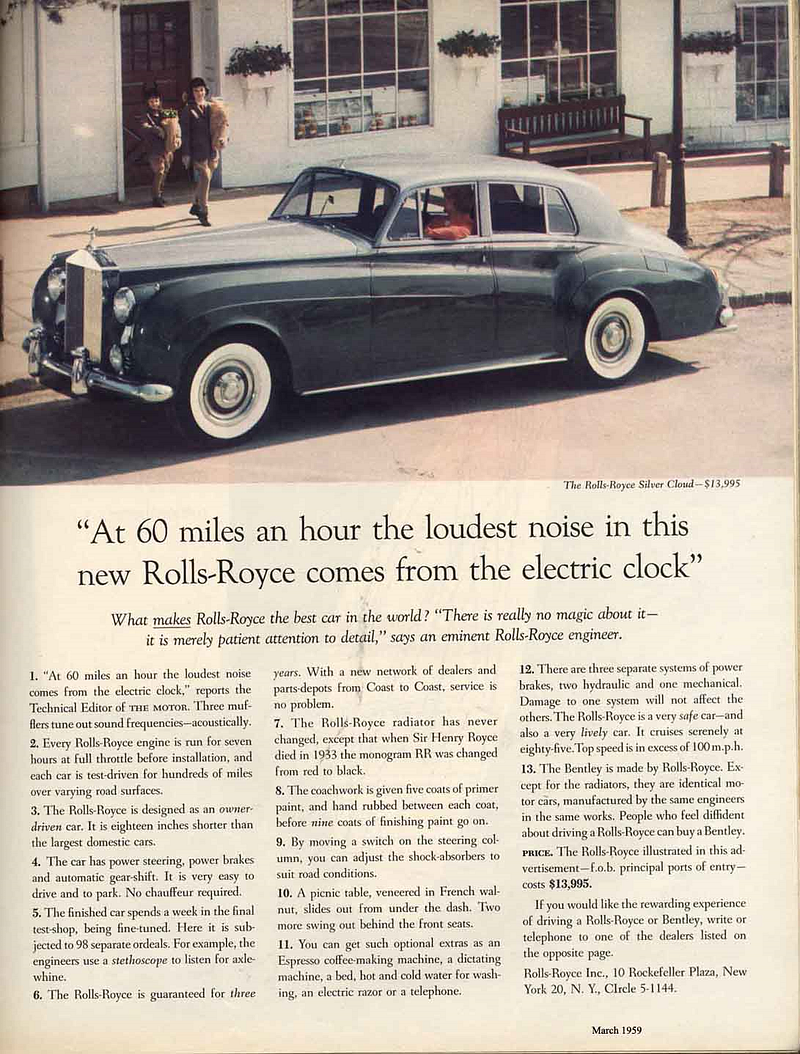David Ogilvy’s 3 Requirements for Writing Advertisements that Sell
Want to write advertisements that make the cash register ring? Do these three things.

Positioning, brand image, big idea.
According to Ogilvy, these are three pillars of producing advertising that sells.
The average person is bombarded with advertisements all day, every day. More than they can handle.
How do you get someone to buy your product? Or use your service when there’s a sea of options out there?
It used to be if you could be the loudest, you’d win. Now the internet has changed all that. Everyone has the potential for being the loudest.
Your advertisement can be loud and in their face but it won’t necessarily make the cash register ring. Customers are smarter than ever now. They still don’t really know what they want but they do know how well the other guys did it.
The quality of goods and services is going up. And no matter what you’re offering, your customers will compare you to the best experience they’ve ever had.
I was in Austin with my God Father the other day. And there are two electric scooter companies who have taken over the city. We wanted to join in. So we found two scooters, one from Brand 1 and another from Brand 2. I signed up and was rolling down the street before my God Father had even got through the form. User error? Perhaps. But 5-minutes later he still wasn’t signed up, so I tried and I couldn’t get through either. So we ditched Brand 2 and rode Brand 1 for the rest of the trip.
If getting in an Uber takes two taps and your offering takes multiple attempts and a lengthy payment method, who do you think they’ll choose?
A) Positioning
‘My own definition (of positioning) is what the product does, and who is it for?’
A good advertisement answers these two questions.
Ogilvy gives an example of how he positioned Dove.
‘I could have positioned Dove as a detergent bar for men with dirty hands, but chose instead to position it as a toilet bar for women with dry skin. This is still working 25 years later.’
People don’t buy your product. They buy the story they can tell themselves when they own it.
No one needs the latest iPhone. A phone half the price will do a similar job. But if you own it, you’re one of the people with the latest iPhone. You broadcast to the world, ‘Hey, I’ve got the resources to get the latest iPhone.’
When you position your product or service, what promise are you offering?
‘We save product managers time by…’ Or ‘this software will save you $1000 per week on your stock ordering.’
1. What does your product do?
2. Who is it for?
Remember these two questions when writing your next advertisement.
B) Brand Image
People love coffee. It’s the second biggest commodity next to oil. 2.2 billion cups are drunk worldwide every day.
Coffee is cheap. My friend runs a coffee business. He says the average mark up on a cup of coffee is 800–1000%.
So why do you pay $5 for a coffee at your favourite place versus the $1 you could spend at the corner store?
It’s because your favourite place has a brand behind it. You know the owner, Sarah, the beans are sourced from somewhere, ‘there’s a slight hint of caramel in this months blend.’
‘The brand image is 90 per cent of what the distiller has to sell.’ — Ogilvy on the three main whiskey distillers in the US.
There isn’t much difference between one cup of coffee or one bottle of whiskey apart from the image behind it.
Brand image is saying, ‘people like us, do things like this.’
Coca-Cola doesn’t tell you how many coca leaves go into their soda, instead they show you pictures of attractive people drinking Coca-Cola and having the time of their lives.
‘Researchers at the Department of Psychology at the University of California gave distilled water to students. They told some of them that it was distilled water, and asked them to describe its taste. Most said it had no taste of any kind. They told the other students that the distilled water came out of the tap. Most of them said it tasted horrible. The mere mention of tap conjured up an image of chlorine.’
What will people think of when they think of your brand?
Tap water or distilled water?
C) Where’s the big idea?
‘It takes a big idea to attract the attention of customers and get them to buy your product. Unless your advertising contains a big idea, it will pass like a ship in the night.’
But where do you get a big idea?
‘Big ideas come from the unconscious. This is true in art, in science and in advertising. But your unconscious has to be well informed, or your idea will be irrelevant.’
There are no guidelines to getting the muse to show up. But one thing is for sure. For it to arrive, you have to do your homework.
Ogilvy was researching for a Rolls Royce campaign when he comes across the line, ‘At 60 miles per hour, the loudest thing in the Rolls Royce is the electric clock.’

Then it became one of the greatest headlines of all time.
Who’s more likely to think of a big idea?
John: ‘I never do research about the product, I rely on intuition alone.’
Or
Rachel: ‘I spend the first week of any campaign learning everything I can about what I’m creating a campaign for, who uses it, who doesn’t use it, why they use it.’
Ogilvy was considered one of the best creatives of his time but even he felt the difficulties of identifying good ideas.
‘It is horribly difficult to recognize a good idea. I shudder to think how many I have rejected. Research can’t help you much, because it cannot predict the cumulative value of an idea, and no idea is big unless it will work for thirty years.’
He then goes on to talk about five questions he uses to help recognise big ideas.
- Did it make be gasp when I first saw it?
- Do I wish I had thought of it myself?
- Is it unique?
- Does it fit the strategy to perfection?
- Could it be used for 30 years?
Big ideas are hard to come by but by doing your research and asking the right questions, you can give yourself the best chance of finding them.
What next?
Life is about selling. Selling your skill set to a job interviewer, selling yourself to a future partner, selling your product or service to customers.
The internet has exposed us to all kinds of offerings and it’s no longer enough to build a great product and they will come. Even the greatest products won’t sell if you’ve got no shelf space. And the internet has a lot of shelf space. But how do you use yours best?
Position your offering well. What does it do and who is it for? What can you do and who will benefit from your service?
Create a brand image people will remember. Your personal brand is what you repeatedly do. The same goes for your product or service. Remember, quality is always a favourable trait.
To dream up big ideas, do your research. Become an expert in what you’re offering. Amateurs rarely have big ideas.
The next time you want to sell anything. Remind yourself of these pillars.
Still want more? Ogilvy on Advertising and The Unpublished David Ogilvy are two of my favourite reads.
